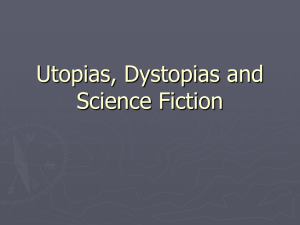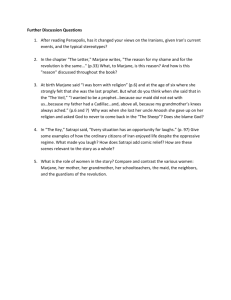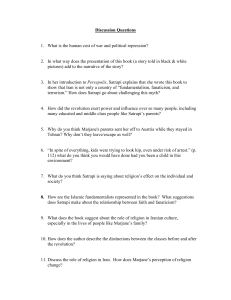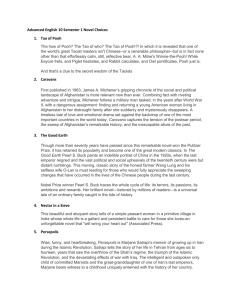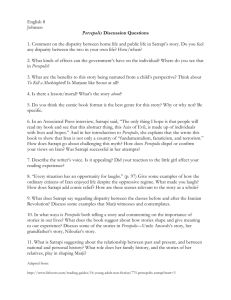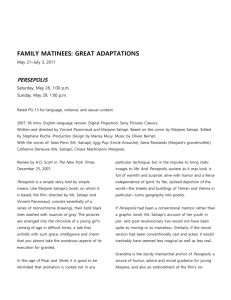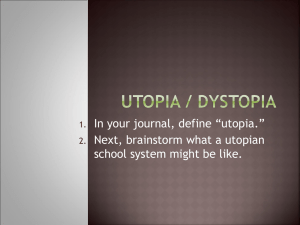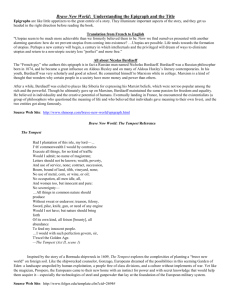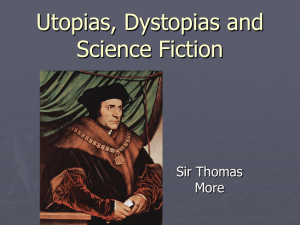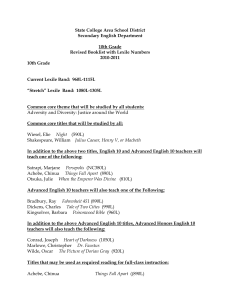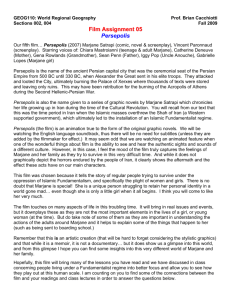RHET/CORE 1010 Themes 2014 - The American University in Cairo
advertisement
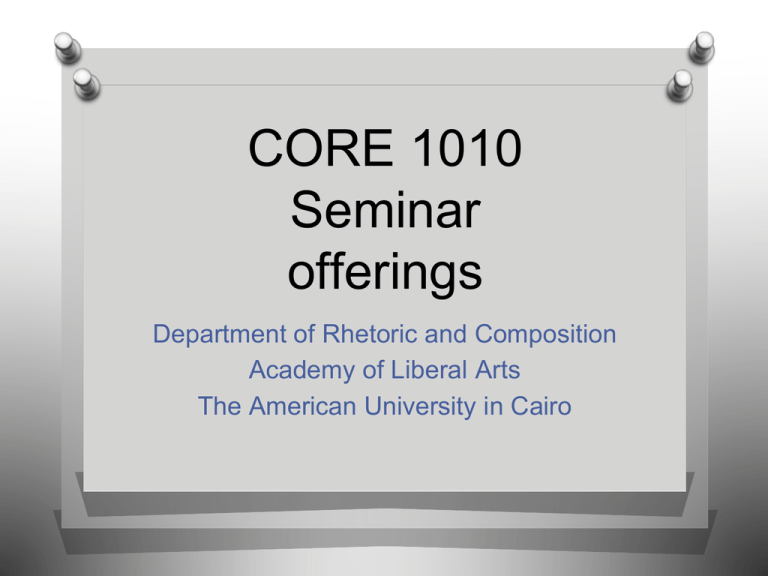
CORE 1010 Seminar offerings Department of Rhetoric and Composition Academy of Liberal Arts The American University in Cairo Course Titles 1. Creative Expressions of Resistance 2. How do we know what's true? 3. 4. 5. 6. 7. 8. 9. 10. 11. 12. Imagining Exile Of Heroes and Demons Filming Difference: Perceptions of of Nations, Borders, Race and Identity Civic Engagement, Public Leadership and the Right to be Human A Beautiful Mind: 21st Century Learning Advertology Exploring the Big Questions Who Am I? Imagined Worlds: Utopias and Dystopias Vision Machines: The Story of Inventions and Everyday Life “Creative Expressions of Resistance” What is the role of the artist in the face of oppression? How can artistic expression be itself a form of resistance? In this course we will reflect on creative responses to oppression and explore various ways individuals and societies have expressed resistance to power. Artistic expressions such as poetry, music, visual art, and comics will be studied in conjunction with their political and cultural groundings. “Art of Resistance.” Logo. Web. 24 May 2013. Main Texts Books: Persepolis, Marjane Satrapi. Pantheon, 2003. Films: Granito: How to Nail a Dictator Dir. Pamela Yates, 2005. Persepolis. Dir. Marjane Satrapi, 2007. How to Start a Revolution, Dir. Ruardh Arrow, 2011. Paradise Now, Dir. Hany Abu-Assade, 2005. Plus many poems, music, short stories, visual art, articles, and political cartoons. Satrapi, Marjane. Persepolis.Web. 24 May 2013. Many of us have accepted that the path to truth feels a lot like this… Or perhaps worse, this… Readings and Themes Elizabeth Sherman “Science and Antiscience in America.” “So what if science doesn’t inform the decisions we make as a country, a people, a world? The answer is that people suffer.” David Grann “Trial by Fire” How did so many well-intentioned people get it so wrong? Answers of Cognitive Science and Psychology Daniel Schacter. “Building Memories: Encoding and Retrieving the Present and the Past.” K.C. Cole. “Seeing Things.” Susan Engel. “Then and Now: Creating a Self Through the Past.” Sarah Trenholm and Arthur Jensen. “Interpretive Competence.” Roger Schank. “Understanding Other People’s Stories.” Stanley Milgram: “Some Conditions on Obedience to Authority.” Malcolm Gladwell, Blink. Another case Doubt, the film (or the play by John Patrick). “Truth in dictionary.” Dreamstime.com. Web Imagine the process of emigration from taking the decision to encountering the new country and deciding whether to become part of immigrant communities or whether to fully integrate to negotiating an identity and visiting the homeland once more. Consider why people cross borders seeking new homelands and how the experience of exile oscillates between engagement and estrangement. Main Texts As well as a selection of academic articles, institutional documents, stand-up comedy, film excerpts, performances and podcasts, Filming Difference: Perceptions of Nations, Borders, Race and Identity Selected Readings Introduction to Documentary Film (Bill Nichols, 2nd Edition) E-Book Arab Cinema: History and Cultural Identity (Viola Shafik) E-Book Alfred Hitchcock: Frame by Frame The Auteur The Four Hundred Blows (Francois Truffaut) 1959 M (Fritz Lang) 1931 Metropolis (Fritz Lang) 1927 The Asphalt Jungle (John Huston) 1950 The Man with the Movie Camera (Dziga Vertoz) 1929 Readings Civic Engagement, Public Leadership and the Right to be Human ✓ Connection between human rights and the way they are protected. ✓ Role citizens can and should play. ✓ AUC’s potential for service learning and student leadership. ✓ CBL to determine and evaluate how the notions of leadership, citizenship and democracy relate to everyday life. O How are human rights and social justice the same and different? O How can we evaluate civic engagement programs? O What is civic engagement and how can it enhance social justice? O What is leadership? Can it be learned? O What does service learning look like elsewhere? O Can liberal arts launch students into a lifetime of civic engagement ? “Let knowledge grow from more to more,. But more of reverence in us dwell.” Lord Alfred Tennyson (Poet Laureate) “The illiterate of the 21st century will not be those who cannot read and write, but those who cannot learn, unlearn, and relearn.” Alvin Toffler (writer and futurist) Readings mainly from: Who am I? A practical and theoretical exploration of different approaches to human consciousness and the self in the sciences, psychology, philosophy, the arts, and religion. Death Coma NDE’s After-life NeuroBiological: Left-Right Brain Cellular Perception Memory Drugs Automatic Brain Typology SpiritualReligious Meditation Being Present Psychology: Sub-personalities The Shadow Self and Other Selves: Social Norms Cultural Values/ Spiral Dynamics The Human Quest: Exploring the “Big Questions” Weeks 1-4: Who am I? How do we maintain our identities in an age of globalization? Weeks 5-9: Where do we come from? Why have some societies come to dominate others? Weeks 10-12: What does it mean to be human? What do the arts tell us about the human condition? Weeks 12-14: Where are we going? What are some of the moral and ethical issues facing humankind? Doyle, D. (2006). Bedouin Woman. Readings Poems by Leslie Marmon Silko, Naomi Shihab Nye, Scott Momaday, and an Aztec poet. Short stories: “This is What it Means to Say Phoenix, Arizona” by Sherman Alexie, “Corncobs” by Salwa Bakr, “The Last and Final Continent” by Jhumpa Lahiri, “The Shell Collector” by Anthony Doerr Imagined Worlds: Utopias and Dystopias From Plato’s Republic, to Suzanne Collins’ The Hunger Games, literature is full of examples of imagined utopias that promise harmony and happiness for their citizens... but as the rules multiply to ensure their success, these imagined utopias often turn into their very opposite: dystopias… O What are utopias and dystopias? O Why do we desire to establish a paradise on earth? O What can go wrong with this? O Where is the line between the dream and the nightmare? O How can the enchanted world help us to deal with the real world? Vision Machines: The Story of Inventions and Everyday Life Module 1: Body Module 2: Text Leonardo da Vinci “Vitruvius Man” Creative Commons. “Remington Portable Manual” Machines of Loving Grace. Module 3: Image Still from Frankenstein (James Whale, 1931). Kenwood Electric Chef from RetroCake
